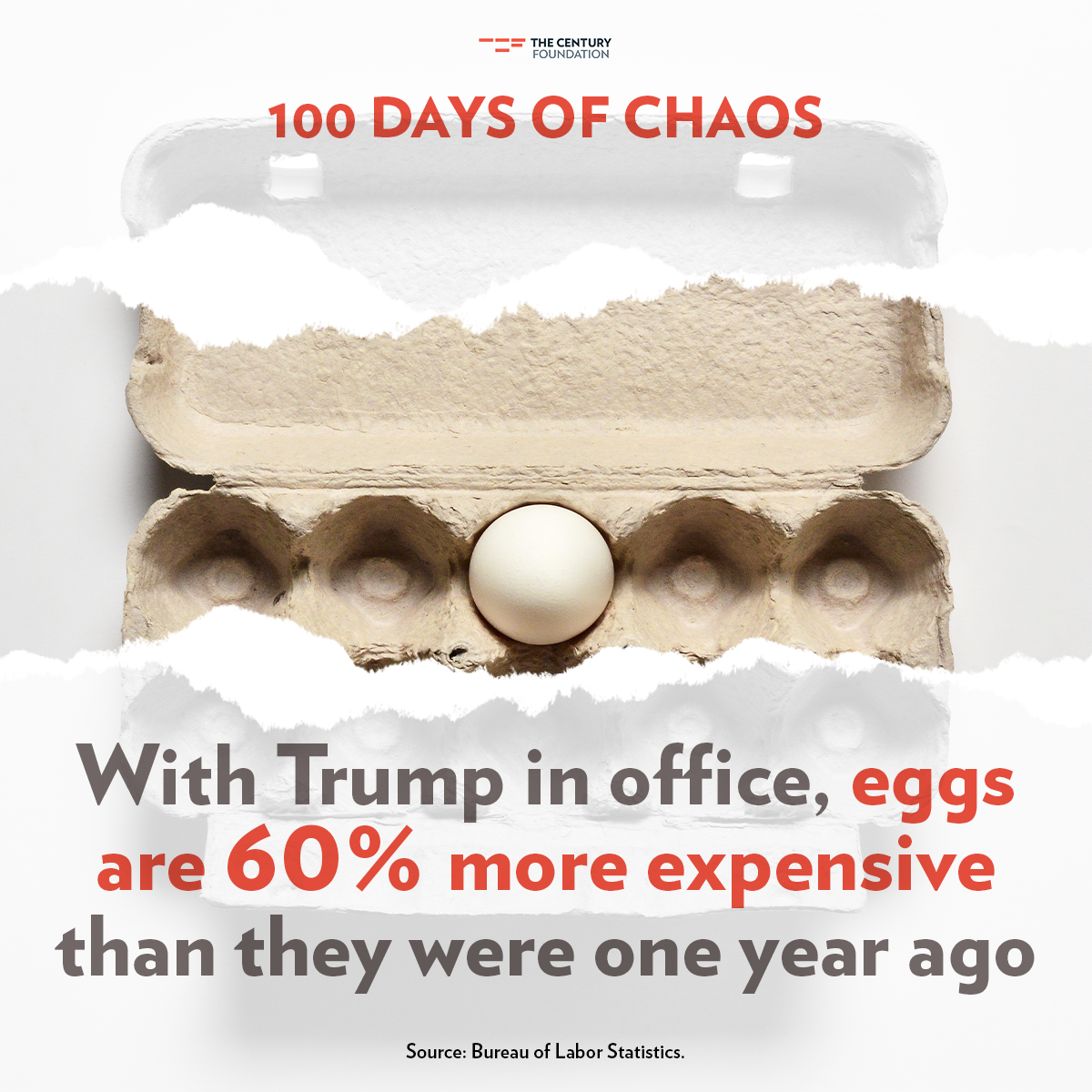President Trump came into office with a promise to boost the economy and lower prices for families, pledging that “A vote for Trump means your groceries will be cheaper.” Instead, the first 100 days of the Trump administration has been filled with chaotic actions that have threatened the economy and the financial well-being of families and communities across the country.
Below are five concrete indicators of the impact of Trump’s actions on the economy now, and the damage to come. Taken together, these indicators show a slowing economy, in which the high cost of living will continue to make it challenging for families to get by and in which it will be harder for families to access critical services that before they had depended on.
Cost of Living
60.4 percent—How much higher egg prices are than they were a year ago.
President Trump campaigned on lowering the cost of groceries. This has not yet happened; in fact, food prices are getting higher, taking up a growing chunk of family budgets. The price of eggs is the most shocking, up 5.9 percent seasonally adjusted in March alone and 60.4 percent over the past twelve months—that’s nearly double the growth rate in December, when they were rising at 31.9 percent. And it’s not just bird flu, since it’s more than egg prices that are going up. In December, the price of all food items were rising by 2.5 percent on an annual basis and now they are rising more quickly, at 3.0 percent annually as of March.

The problem of rising prices is likely to get worse in the coming months. Since January, nearly every major forecaster has sharply increased their expectations for this year’s inflation rate—with many saying it will be well over 4 percent for the year—as the potential impact of tariffs on the prices Americans pay for imported goods could soon skyrocket, according to Federal Reserve chairman Jerome Powell.
Retirement Security
$9.6 trillion—How much wealth was lost in the stock market since Trump took office.
The Standard and Poor’s 500 (S&P 500), a large representative index of the top 500 companies in the United States, is currently down by 9 percent since Trump took office. The drop in the S&P 500 indicates that Trump’s volatile economic policies over the past 100 days have erased $9.6 trillion in wealth.

The stock market is where Americans invest much of their wealth, increasingly for retirement as companies move away from providing traditional pension plans. Over half of households have a retirement savings plan that would be impacted by the stock market turmoil, such as Individual Retirement Accounts (IRAs) or defined contribution plans such as 401(k)s. Overall, more than 60 percent of Americans have at least some stake in the stock market. Critically, for those who are close to or already in retirement, these losses may not be reversible, meaning that, after a lifetime of work, they won’t have the resources they thought they’d have to support a stable retirement.
Children’s Well-Being
790,000—The number of children in Head Start whose early education is at risk.
The Trump administration has proposed completely eliminating the Head Start program, beginning in October 2025. Head Start provides free early childhood education to young children in low-income families every year as well as providing services to their parents to connect them to jobs, job training, education, housing, and health services. Last year, the program served more than 790,000 children and their families. The administration has already reduced support for Head Start programs, delaying funds that led to one program to temporarily close in Washington, and through a broad layoffs to the Office of Head Start, which administers and oversees the program.

The Trump budget move would set back a generation of children from low-income families deprived of the proven benefits of Head Start, cause significant unemployment among the poorest families who will lose access to free child care arrangements, increase child care costs for these families, and result in job loss for the many early educators, social workers, bus drivers, and other Head Start program staff in every corner of America.
Consumer Confidence
Down 30 percent—The drop in consumer confidence since Trump took office.
Consumer confidence—essentially, a measure of the American consumer’s real-time sense of how the economy is doing—has plummeted. The index of consumer sentiment as measured by the University of Michigan has dropped by 15 points, or 30 percent, since Trump took office, including 11 points in April alone, marking the fourth consecutive month of declining consumer sentiment. By some measures, it is the second-lowest consumer confidence University of Michigan has reported since 1952.

Consumer confidence is a powerful harbinger and a drop this large means many Americans are pessimistic about their economic future. Concerningly, across all five categories—expectations for business conditions, personal finances, incomes, inflation, and labor markets—consumer sentiment declined. People this worried about losing their jobs, not being able to save, and rising prices are going to curtail their spending, further risking a national slide into recession. Americans—regardless of political affiliation, gender, age, and geography—share these growing concerns. Falling confidence isn’t limited to consumers, either; nearly every major forecaster has sharply revised down their outlook for the U.S. economy.
Jobs
275,000—Layoffs announced in March.
According to one outsourcing company, job cuts in March were 60 percent higher than in the previous month, representing the third-highest monthly reduction since the company started tracking layoff announcements in 1989. More than three out of four of these announced job cuts come from mass firings of federal workers by Elon Musk and the Department of Government Efficiency (DOGE).

The harm from job loss of this magnitude will extend far beyond the workers, families, industries, and regions impacted. Not only will this job loss push unemployment higher, but because these job cuts are being made at agencies such as the Social Security Administration and the Centers for Medicare & Medicaid Services, they will also harm the government’s ability to effectively and efficiently provide the services that families rely on, particularly during hard economic times.
Conclusion
The Trump administration’s first 100 days have been traumatic for American families. And, as the impacts of Trump’s cutbacks and titanic tariff policy reverberate throughout the economy, the situation could get much worse, interrupting and reversing the period of steady and stable economic growth that defined the post-pandemic recovery.
Tags: donald trump, us economy, 100 days
100 Days of Chaos: Rising Prices, Falling Markets, and Suffering Families
President Trump came into office with a promise to boost the economy and lower prices for families, pledging that “A vote for Trump means your groceries will be cheaper.” Instead, the first 100 days of the Trump administration has been filled with chaotic actions that have threatened the economy and the financial well-being of families and communities across the country.
Below are five concrete indicators of the impact of Trump’s actions on the economy now, and the damage to come. Taken together, these indicators show a slowing economy, in which the high cost of living will continue to make it challenging for families to get by and in which it will be harder for families to access critical services that before they had depended on.
Cost of Living
60.4 percent—How much higher egg prices are than they were a year ago.
President Trump campaigned on lowering the cost of groceries. This has not yet happened; in fact, food prices are getting higher, taking up a growing chunk of family budgets. The price of eggs is the most shocking, up 5.9 percent seasonally adjusted in March alone and 60.4 percent over the past twelve months—that’s nearly double the growth rate in December, when they were rising at 31.9 percent. And it’s not just bird flu, since it’s more than egg prices that are going up. In December, the price of all food items were rising by 2.5 percent on an annual basis and now they are rising more quickly, at 3.0 percent annually as of March.
The problem of rising prices is likely to get worse in the coming months. Since January, nearly every major forecaster has sharply increased their expectations for this year’s inflation rate—with many saying it will be well over 4 percent for the year—as the potential impact of tariffs on the prices Americans pay for imported goods could soon skyrocket, according to Federal Reserve chairman Jerome Powell.
Retirement Security
$9.6 trillion—How much wealth was lost in the stock market since Trump took office.
The Standard and Poor’s 500 (S&P 500), a large representative index of the top 500 companies in the United States, is currently down by 9 percent since Trump took office. The drop in the S&P 500 indicates that Trump’s volatile economic policies over the past 100 days have erased $9.6 trillion in wealth.
The stock market is where Americans invest much of their wealth, increasingly for retirement as companies move away from providing traditional pension plans. Over half of households have a retirement savings plan that would be impacted by the stock market turmoil, such as Individual Retirement Accounts (IRAs) or defined contribution plans such as 401(k)s. Overall, more than 60 percent of Americans have at least some stake in the stock market. Critically, for those who are close to or already in retirement, these losses may not be reversible, meaning that, after a lifetime of work, they won’t have the resources they thought they’d have to support a stable retirement.
Children’s Well-Being
790,000—The number of children in Head Start whose early education is at risk.
The Trump administration has proposed completely eliminating the Head Start program, beginning in October 2025. Head Start provides free early childhood education to young children in low-income families every year as well as providing services to their parents to connect them to jobs, job training, education, housing, and health services. Last year, the program served more than 790,000 children and their families. The administration has already reduced support for Head Start programs, delaying funds that led to one program to temporarily close in Washington, and through a broad layoffs to the Office of Head Start, which administers and oversees the program.
The Trump budget move would set back a generation of children from low-income families deprived of the proven benefits of Head Start, cause significant unemployment among the poorest families who will lose access to free child care arrangements, increase child care costs for these families, and result in job loss for the many early educators, social workers, bus drivers, and other Head Start program staff in every corner of America.
Consumer Confidence
Down 30 percent—The drop in consumer confidence since Trump took office.
Consumer confidence—essentially, a measure of the American consumer’s real-time sense of how the economy is doing—has plummeted. The index of consumer sentiment as measured by the University of Michigan has dropped by 15 points, or 30 percent, since Trump took office, including 11 points in April alone, marking the fourth consecutive month of declining consumer sentiment. By some measures, it is the second-lowest consumer confidence University of Michigan has reported since 1952.
Consumer confidence is a powerful harbinger and a drop this large means many Americans are pessimistic about their economic future. Concerningly, across all five categories—expectations for business conditions, personal finances, incomes, inflation, and labor markets—consumer sentiment declined. People this worried about losing their jobs, not being able to save, and rising prices are going to curtail their spending, further risking a national slide into recession. Americans—regardless of political affiliation, gender, age, and geography—share these growing concerns. Falling confidence isn’t limited to consumers, either; nearly every major forecaster has sharply revised down their outlook for the U.S. economy.
Jobs
275,000—Layoffs announced in March.
According to one outsourcing company, job cuts in March were 60 percent higher than in the previous month, representing the third-highest monthly reduction since the company started tracking layoff announcements in 1989. More than three out of four of these announced job cuts come from mass firings of federal workers by Elon Musk and the Department of Government Efficiency (DOGE).
The harm from job loss of this magnitude will extend far beyond the workers, families, industries, and regions impacted. Not only will this job loss push unemployment higher, but because these job cuts are being made at agencies such as the Social Security Administration and the Centers for Medicare & Medicaid Services, they will also harm the government’s ability to effectively and efficiently provide the services that families rely on, particularly during hard economic times.
Conclusion
The Trump administration’s first 100 days have been traumatic for American families. And, as the impacts of Trump’s cutbacks and titanic tariff policy reverberate throughout the economy, the situation could get much worse, interrupting and reversing the period of steady and stable economic growth that defined the post-pandemic recovery.
Tags: donald trump, us economy, 100 days